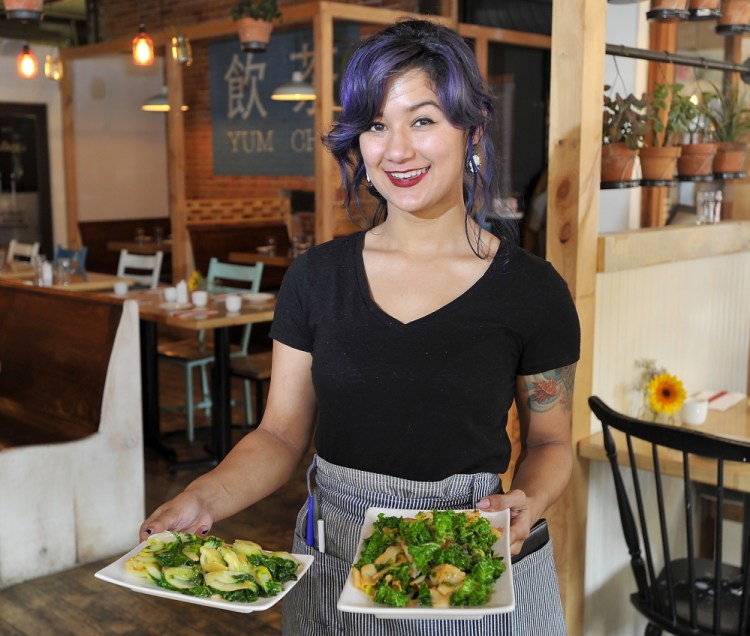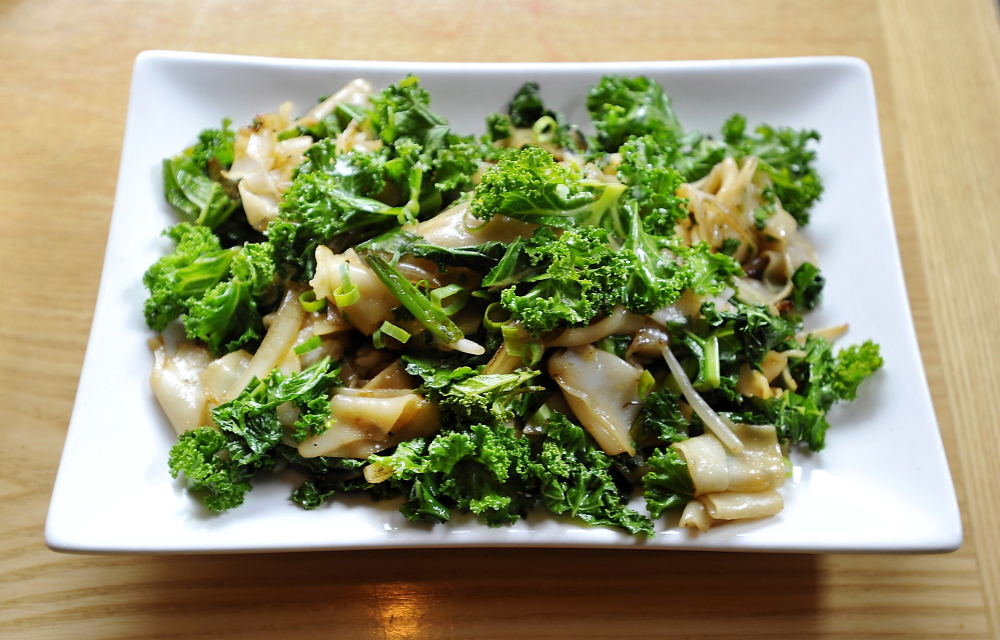Portland restaurants report their diners are liking leafy.
When Theresa Chan says locals love their greens, she’s not kidding. The owner of Empire Chinese Kitchen in Portland estimates the restaurant serves up to 100 pounds of leafy greens each week.
“Here in Portland people go wild for vegetables,” said Chan, who opened the Arts District eatery on Congress Street with Todd Bernard last fall. “I think people are looking for nourishing and healthful food.”
Chan told me the restaurant’s top-selling dish is garlic green beans and the multiple leafy green dishes on the menu are “very popular.” The spinach dumplings have even won approval from the many Chinese tourists who visit the restaurant, she said.
In addition to those dumplings, the menu includes sautéed baby bok choy and kale with noodles. All three dishes are vegan and gluten-free. Right now the restaurant is also running a special of sautéed snow pea leaves, which Chan describes as a cross between spinach and watercress.
As summer’s salads fade into memory, leafy vegetables with a bit more heft move into the spotlight. Maine farmers grow them all winter long, and it’s no secret they’re packed with health-boosting properties. And these days leafy greens star in vegetarian dishes at a number of Portland restaurants.
Two years ago when the long-running David’s restaurant in Monument Square decided to add wholly plant-based options to its menu, the chefs wanted to highlight leafy greens.
Both spinach and arugula play a prominent role in the dish the restaurant bills as vegan stir fry.
“We picked things we already had in the restaurant,” sous chef Kelsey O’Connor told me.
O’Connor helped developed the dish, which he describes as composed of “ginger and soy but also there’s a little leek and shallot, broccoli and asparagus, pea tendrils from Olivia’s Garden, white beans and julienned vegetables (carrots and red onion) that get tossed in at the end.”
The spinach and arugula are ripped by hand and added just before the pan comes off the heat, so the greens wilt but retain a bit of crunch.
“The spinach is hearty but very healthy,” O’Connor said. “Arugula is a nice peppery green, and those two combined really work well.”
For years, the awesome vegetarian pizza has been a menu staple at David’s, and it also features spinach. The key is to wilt it first, O’Connor said. At David’s, the chefs spread it out on a sheet pan, spray it lightly with oil and season it with salt and pepper. Then the pan is placed in the pizza oven until the spinach wilts, which takes less than a minute. The chefs add the spinach after layering the crust with oven-dried tomatoes, caramelized onions, peppers, mushrooms and olives, and they top the pizza with fresh mozzarella.
David’s seasonal vegan pizza also features leafy greens, in the form of roasted Brussels sprouts and parsley oil. Those are paired with cauliflower, mashed sweet potatoes, red onions, roasted squash and a white bean purée.
At the all-vegetarian Green Elephant across from the State Theatre, leafy greens show up in many of the vegetarian and vegan dishes. Unique among them is the Green Leaves Wrap with Mango and Herbs, the restaurant’s only totally raw offering.
“It’s really popular,” Green Elephant’s head of house Ben Richards told me. “We could never get rid of it.”
The appetizer has been on the menu since the restaurant opened in 2007. Richards said the wait staff recommend it for balance with the richer cooked entrées, such as Singapore noodles or veggie citrus “spare ribs” (both prepared with bok choy).
The large collard leaves serve as a wrap around a crunchy mix of red cabbage, julienned carrots, cilantro and fresh mango. It’s served with a sweet tamarind dipping sauce, which along with the mango helps neutralize the slight bitterness of the raw collard leaves.
To use a collard leaf as a raw wrap, it’s important to look over the collard bunch before you buy it to make sure most of the leaves don’t have tears, Richard said. The second essential is to use a paring knife to whittle down the thick center stem. The Green Elephant chefs roll the leaves very tightly so the wraps won’t unfold. The ends are trimmed and the roll is cut in half.
Back at Empire, Chan says the kitchen’s basic vegetarian sauté (used on the bok choy and green pea leaves) involves blanching the greens and then finishing them in the wok. They’re seasoned with slivered garlic and ginger, tamari, salt, sugar and white pepper.
“You kind of char the vegetables with the wok heat,” Chan said. Your wok technique “has to be incredibly fast so everything gets a nice even searing on all sides.”
For those popular spinach dumplings, a key ingredient is actually corn. Chan explains that meat-filled dumplings tend to swell when cooking. In contrast, spinach and other vegetables tend to shrink. To keep the vegetarian dumplings from collapsing, the chefs add corn, which holds its shape under high heat.
“We keep it simple,” said Chan. “Because in Chinese cooking the goal is to preserve the natural integrity of the food.”
Chan said the restaurant’s vegetable-rich menu reflects traditional Chinese ideas about food and dining.
“Leafy greens are customary,” Chan said. “They’re fresh and bright and signify bounty at the table.”
And like a good-for-us form of peer pressure, Chan says seeing people eat leafy greens entices others to do the same.
“Customers see greens on other tables,” Chan said. “And they say, ‘That looks good. I need that.’ ”
Avery Yale Kamila is a freelance food writer who lives in Portland. She can be reached at:
avery.kamila@gmail.com
Twitter: AveryYaleKamila
Send questions/comments to the editors.




Success. Please wait for the page to reload. If the page does not reload within 5 seconds, please refresh the page.
Enter your email and password to access comments.
Hi, to comment on stories you must . This profile is in addition to your subscription and website login.
Already have a commenting profile? .
Invalid username/password.
Please check your email to confirm and complete your registration.
Only subscribers are eligible to post comments. Please subscribe or login first for digital access. Here’s why.
Use the form below to reset your password. When you've submitted your account email, we will send an email with a reset code.